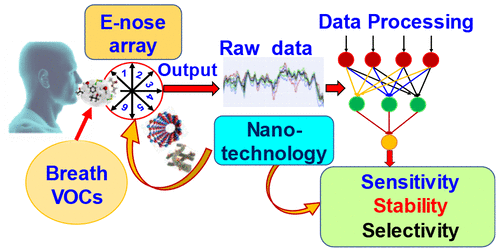Our official English website, www.x-mol.net, welcomes your feedback! (Note: you will need to create a separate account there.)
Prospects and Challenges of Volatile Organic Compound Sensors in Human Healthcare
ACS Sensors ( IF 8.9 ) Pub Date : 2018-06-08 00:00:00 , DOI: 10.1021/acssensors.8b00400 Ahmed H. Jalal 1 , Fahmida Alam 1 , Sohini Roychoudhury 1 , Yogeswaran Umasankar 2 , Nezih Pala 1 , Shekhar Bhansali 1
ACS Sensors ( IF 8.9 ) Pub Date : 2018-06-08 00:00:00 , DOI: 10.1021/acssensors.8b00400 Ahmed H. Jalal 1 , Fahmida Alam 1 , Sohini Roychoudhury 1 , Yogeswaran Umasankar 2 , Nezih Pala 1 , Shekhar Bhansali 1
Affiliation

|
The chemical signatures of volatile organic compounds (VOCs) in humans can be utilized for point-of-care (POC) diagnosis. Apart from toxic exposure studies, VOCs generated in humans can provide insights into one’s healthy and diseased metabolic states, acting as a biomarker for identifying numerous diseases noninvasively. VOC sensors and the technology of e-nose have received significant attention for continuous and selective monitoring of various physiological and pathophysiological conditions of an individual. Noninvasive detection of VOCs is achieved from biomatrices of breath, sweat and saliva. Among these, detection from sweat and saliva can be continuous in real-time. The sensing approaches include optical, chemiresistive and electrochemical techniques. This article provides an overview of such techniques. These, however, have limitations of reliability, precision, selectivity, and stability in continuous monitoring. Such limitations are due to lack of sensor stability and complexity of samples in a multivariate environment, which can lead to false readings. To overcome selectivity barriers, sensor arrays enabling multimodal sensing, have been used with pattern recognition techniques. Stability and precision issues have been addressed through advancements in nanotechnology. The use of various forms of nanomaterial not only enhance sensing performance, but also plays a major role in detection on a miniaturized scale. The rapid growth in medical Internet of Things (IoT) and artificial intelligence paves a pathway for improvements in human theranostics.
中文翻译:

挥发性有机化合物传感器在人类医疗保健中的前景与挑战
人体中挥发性有机化合物(VOC)的化学特征可用于即时诊断(POC)。除了毒性接触研究外,人体内产生的挥发性有机化合物还可以洞悉人的健康和患病的代谢状态,并作为生物标记物以无创方式识别多种疾病。VOC传感器和电子鼻技术在连续和选择性地监测个体的各种生理和病理生理状况方面受到了极大的关注。通过呼吸,汗液和唾液生物矩阵可以无创地检测VOC。其中,从汗液和唾液中的检测可以实时连续进行。传感方法包括光学,化学和电化学技术。本文提供了此类技术的概述。但是,这些 在连续监控中存在可靠性,精度,选择性和稳定性方面的限制。此类限制是由于缺乏传感器稳定性以及在多变量环境中采样的复杂性而导致的错误读数。为了克服选择性障碍,已将能够进行多模式传感的传感器阵列与模式识别技术一起使用。纳米技术的进步已经解决了稳定性和精度问题。各种形式的纳米材料的使用不仅增强了感测性能,而且在小型化检测中也起着重要作用。医疗物联网(IoT)和人工智能的快速发展为人类人体治疗学的发展铺平了道路。此类限制是由于缺乏传感器稳定性以及在多变量环境中采样的复杂性而导致的错误读数。为了克服选择性障碍,已将能够进行多模式传感的传感器阵列与模式识别技术一起使用。纳米技术的进步已经解决了稳定性和精度问题。各种形式的纳米材料的使用不仅增强了感测性能,而且在小型化检测中也起着重要作用。医疗物联网(IoT)和人工智能的快速发展为人类人体治疗学的发展铺平了道路。此类限制是由于缺乏传感器稳定性以及在多变量环境中采样的复杂性而导致的错误读数。为了克服选择性障碍,已将能够进行多模式传感的传感器阵列与模式识别技术一起使用。纳米技术的进步已经解决了稳定性和精度问题。各种形式的纳米材料的使用不仅增强了感测性能,而且在小型化检测中也起着重要作用。医疗物联网(IoT)和人工智能的快速发展为人类人体治疗学的发展铺平了道路。已经与模式识别技术一起使用。纳米技术的进步已经解决了稳定性和精度问题。各种形式的纳米材料的使用不仅增强了感测性能,而且在小型化检测中也起着重要作用。医疗物联网(IoT)和人工智能的快速发展为人类人体治疗学的发展铺平了道路。已经与模式识别技术一起使用。纳米技术的进步已经解决了稳定性和精度问题。各种形式的纳米材料的使用不仅增强了感测性能,而且在小型化检测中也起着重要作用。医疗物联网(IoT)和人工智能的快速发展为人类人体治疗学的发展铺平了道路。
更新日期:2018-06-08
中文翻译:

挥发性有机化合物传感器在人类医疗保健中的前景与挑战
人体中挥发性有机化合物(VOC)的化学特征可用于即时诊断(POC)。除了毒性接触研究外,人体内产生的挥发性有机化合物还可以洞悉人的健康和患病的代谢状态,并作为生物标记物以无创方式识别多种疾病。VOC传感器和电子鼻技术在连续和选择性地监测个体的各种生理和病理生理状况方面受到了极大的关注。通过呼吸,汗液和唾液生物矩阵可以无创地检测VOC。其中,从汗液和唾液中的检测可以实时连续进行。传感方法包括光学,化学和电化学技术。本文提供了此类技术的概述。但是,这些 在连续监控中存在可靠性,精度,选择性和稳定性方面的限制。此类限制是由于缺乏传感器稳定性以及在多变量环境中采样的复杂性而导致的错误读数。为了克服选择性障碍,已将能够进行多模式传感的传感器阵列与模式识别技术一起使用。纳米技术的进步已经解决了稳定性和精度问题。各种形式的纳米材料的使用不仅增强了感测性能,而且在小型化检测中也起着重要作用。医疗物联网(IoT)和人工智能的快速发展为人类人体治疗学的发展铺平了道路。此类限制是由于缺乏传感器稳定性以及在多变量环境中采样的复杂性而导致的错误读数。为了克服选择性障碍,已将能够进行多模式传感的传感器阵列与模式识别技术一起使用。纳米技术的进步已经解决了稳定性和精度问题。各种形式的纳米材料的使用不仅增强了感测性能,而且在小型化检测中也起着重要作用。医疗物联网(IoT)和人工智能的快速发展为人类人体治疗学的发展铺平了道路。此类限制是由于缺乏传感器稳定性以及在多变量环境中采样的复杂性而导致的错误读数。为了克服选择性障碍,已将能够进行多模式传感的传感器阵列与模式识别技术一起使用。纳米技术的进步已经解决了稳定性和精度问题。各种形式的纳米材料的使用不仅增强了感测性能,而且在小型化检测中也起着重要作用。医疗物联网(IoT)和人工智能的快速发展为人类人体治疗学的发展铺平了道路。已经与模式识别技术一起使用。纳米技术的进步已经解决了稳定性和精度问题。各种形式的纳米材料的使用不仅增强了感测性能,而且在小型化检测中也起着重要作用。医疗物联网(IoT)和人工智能的快速发展为人类人体治疗学的发展铺平了道路。已经与模式识别技术一起使用。纳米技术的进步已经解决了稳定性和精度问题。各种形式的纳米材料的使用不仅增强了感测性能,而且在小型化检测中也起着重要作用。医疗物联网(IoT)和人工智能的快速发展为人类人体治疗学的发展铺平了道路。



























 京公网安备 11010802027423号
京公网安备 11010802027423号